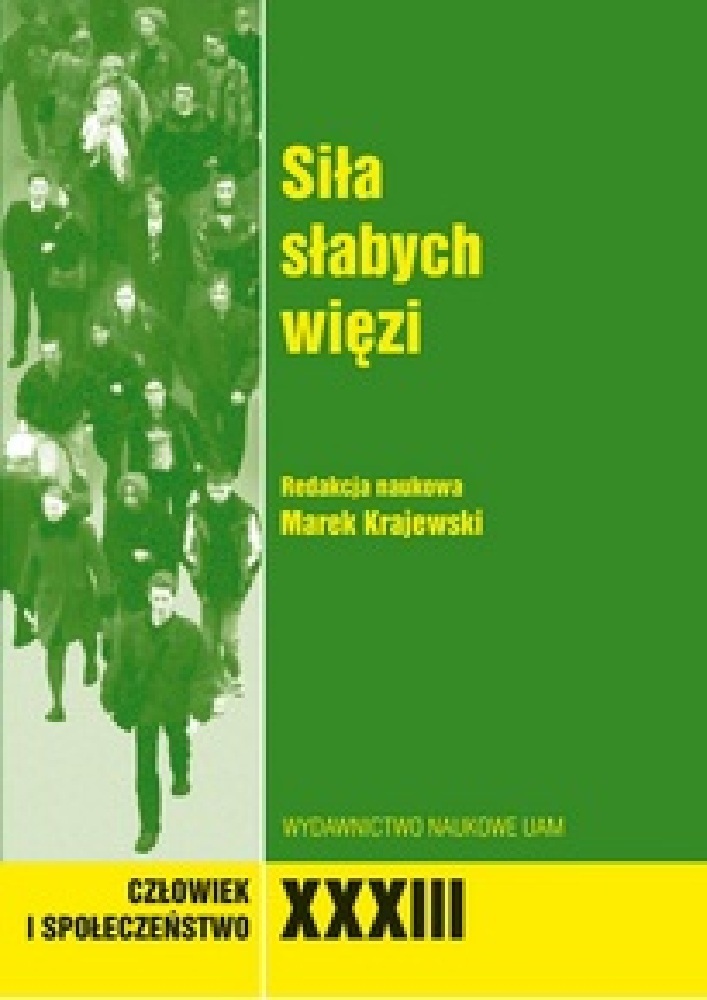Abstrakt
The term “weak ties” can be discussed in the context of both, interpersonal relationships in an anonymous metropolis and a mass society. Can the case of ródka in Pozna" be applied to certain questions relating to the phenomenon of weak ties? It is clearly visible, that revitalisation in this area of the city has lost its momentum now. Municipal program was a temporary way to avoid progressive degradation and increasing gentrification. However, in the most lively period of projects and events at ródka experts often referred to the traditional ties between inhabitants and invoked the urgency of their activities. Even the minimum effort and engagement was to trigger the renovation processes and contribute to the so-called
sustainable development of ródka. It is worth asking at this point, who emphasized the role of local relations and animated the sequence of revitalizing events? What were the goals of revitalization animators? Did we come across the true cooperation of local residents, or perhaps the social participation was limited to the show for "tourists" from other parts of the city? Were the city officials able to engage the community of ródka? And if not the officials – were the artists able to (re)build relationships and connections between inhabitants? Their projects – both individual and group ones – are an important material for research To understand the growing complexity of the case of ródka, it is essential to discover its historical background and consider the relative isolation of ródka in the previous times. In the first half of the twentieth century, the district was perceived as a local base of crafts and small trade. Its distinctive mark were strong neighborhood ties. Can these ties – partly mythologized – now become the driving force of the revitalization?
Bibliografia
Krzyślak B., Kurzawa Z. (2009), Kościół św. Małgorzaty na Śródce w Poznaniu, Poznań
Pawlak C. (2005), Miasto w Mieście. Historia kompleksu fabryczno-mieszkalnego na Księżym Młynie, Łódź
Pazder D. (2008), Rewitalizacja śródmiejskich przestrzeni kulturowych jako czynnik wzrostu atrakcyjności miasta, Poznań
Walczak B.M. (2007), Książęcy Młyn w kontekście rozwoju zespołów fabryczno-mieszkalnych w Europie, [w:] Muzealizacja, rewitalizacja czy destrukcja? Wobec dziedzictwa XIX-wiecznej Architektury, Łódź
Wiesiołowski J. (1996), Targi, targowiska, jarmarki w późnośredniowiecznej aglomeracji poznańskiej, Poznań Śródka, Ostrówek, w. Roch, Kronika Miasta Poznania 1997, J. Wiesiołowski, J. Skuratowicz, B. Walczak, M. Warkoczewska, M. Ziółkowski (red. – 1997), Poznań
Charakterystyka planowania i realizacji Miejskiego Programu Rewitalizacji w Poznaniu, Urząd Miasta Poznania, Biuro Koordynacji Projektów, Oddział Rewitalizacji (2009), Poznań
źródła internetowe:
http://www.e-teatr.pl/pl/artykuly/94485.html.
http://www.kujawska.lap.pl/Katalogi-p_files/katal%20srodka%20web-1.pdf.
http://www.epoznan.pl/?id=10382§ion=kultura&subsection=wydarzenie.
http://wyborcza.pl/1,76842,6381482,Krach_w_Polsce__lud_w_slawojce.html?as=5&ias=6
http://www.poznan.pl/mim/public/s8a/attachments.html?co=show&instance=1017&parent=10072&lang=pl&id=22415, dostęp 20.02.2010, godz. 10:00, dokument PDF, s.29.
http://www.bpp.lublin.pl/oprac2.prirm.html.
http://www.fr.org.pl/images/stories/Konferencja_MRR_K.Skalski.pdf
http://www.kujawska.lap.pl/Katalogi-p_files/katal%20srodka%20web-1.pdf.
Licencja
1. W momencie złożenia pracy celem rozpoczęcia postępowania w sprawie publikacji, Licencjodawca, zwany dalej Autorem, akceptuje wszystkie zasady umieszczone na stronie internetowej czasopisma “Człowiek i Społeczeństwo”, udzielając Licencjobiorcy, zwanego dalej Wydawcą, niewyłącznej i nieodpłatnej licencji na korzystanie z Utworu. Licencja zakłada tym samym brak ograniczeń terytorialnych, czasowych oraz ilościowych na następujących polach eksploatacji (art. 50 ustawy z dnia 4 lutego 1994 r. o prawie autorskim i prawach pokrewnych):
a. utrwalanie Utworu;
b. zwielokrotnienie Utworu drukiem i w wersji cyfrowej;
c. wprowadzenie do obrotu, użyczenie lub najem oryginału/zwielokrotnionych egzemplarzy Utworu;
d. publiczne wykonanie, wystawienie, wyświetlenie, odtworzenie oraz nadawanie i reemitowanie, a także publiczne udostępnianie Utworu w taki sposób, aby każdy mógł mieć do niego dostęp w miejscu i w czasie przez siebie wybranym;
e. włączenie Utworu w skład utworu zbiorowego;
f. wprowadzenie Utworu w postaci elektronicznej na platformy elektroniczne lub inne wprowadzenie Utworu w postaci elektronicznej do Internetu, Intranetu, Extranetu lub innej sieci;
g. rozpowszechnianie Utworu w wersji elektronicznej w Internecie, Intranecie, Extranecie lub innej sieci, w pracy zbiorowej, a także samodzielnie w formule Open Access w oparciu o licencję Creative Commons Uznanie autorstwa 4.0 Międzynarodowa Licencja Publiczna (CC BY 4.0), a także inną wersję językową tej licencji, lub którąkolwiek późniejszą wersję tej licencji.
2. Założenia licencji Creative Commons Uznanie autorstwa 4.0 Międzynarodowa Licencja Publiczna (CC BY 4.0), udzielają Wydawcy upoważnienia do kopiowania, zmieniania, rozprowadzania, przedstawiania i wykonywania Utworu jedynie pod warunkiem uznania autorstwa.
3. Wraz z dostarczeniem Utworu, Autor zobowiązuje się do wypełnienia, podpisania oraz odesłania skanu umowy
